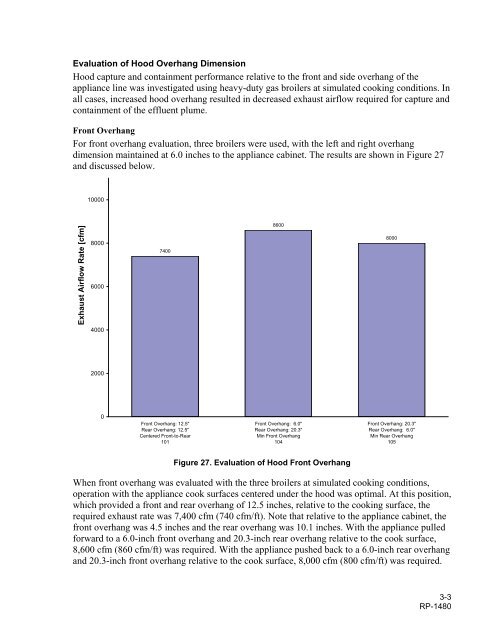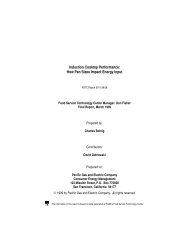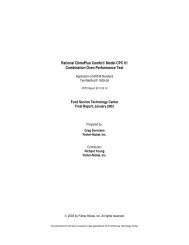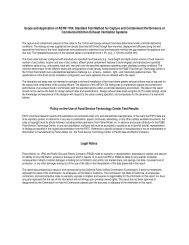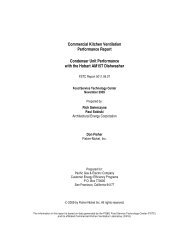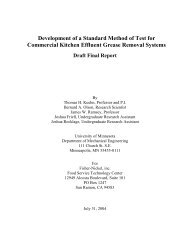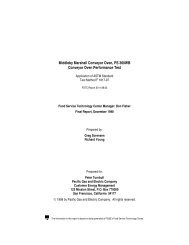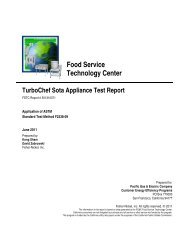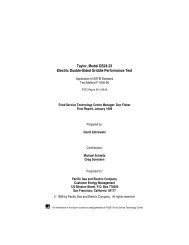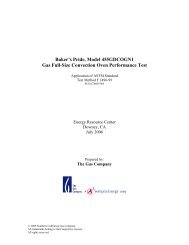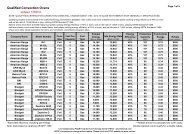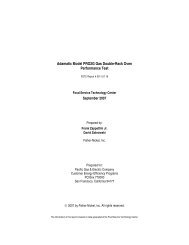- Page 1 and 2: ASHRAE Research Project 1480 Island
- Page 3 and 4: Table of Contents Acknowledgments..
- Page 5 and 6: List of Figures Figure 1. Layout of
- Page 7 and 8: Figure 69. Evaluation of Hood Side
- Page 9 and 10: Preface It has been shown that the
- Page 11 and 12: filter bank. That said, without a w
- Page 13 and 14: Abstract The objective of this rese
- Page 15 and 16: equired to achieve the reported hea
- Page 17 and 18: Table 2. Makeup Air Sensitivity Tes
- Page 19 and 20: Table 5. Negative Pressure Zone Tes
- Page 21 and 22: Hood Specifications Island Hood Spe
- Page 23 and 24: Single Island 10-Foot by 6-Foot V-B
- Page 25 and 26: Double Island 10-Foot by 8-Foot Can
- Page 27 and 28: Without Exhaust Collar Damper With
- Page 29 and 30: Side Panel and Appliance Extension
- Page 31 and 32: 4'-0" 3'-0" 3'-6" Figure 12. Side P
- Page 33 and 34: Figure 14. Side Panel (84.0-inch to
- Page 35 and 36: Ceiling Diffusers Both 4-way ceilin
- Page 37 and 38: The discharge velocities were measu
- Page 39 and 40: measured again. When the two system
- Page 41 and 42: To challenge the capture performanc
- Page 43 and 44: The repeatability of capture and co
- Page 45: Combo (F,B,O) w/Panel #1 Front & Re
- Page 49 and 50: exhaust rate. However, this disadva
- Page 51 and 52: Heavy-Duty (Three Broiler) Applianc
- Page 53 and 54: Combination-Duty Appliance Line For
- Page 55 and 56: Evaluation of Makeup Air Configurat
- Page 57 and 58: Heavy-Duty (One Broiler) Appliance
- Page 59 and 60: Combination-Duty Appliance Line For
- Page 61 and 62: Evaluation of Dynamic Room Conditio
- Page 63 and 64: Single Island V-Bank Canopy Hood, 6
- Page 65 and 66: Heavy(2Broiler) 24" SOhang L&R Perf
- Page 67 and 68: Side Overhang For side overhang eva
- Page 69 and 70: Evaluation of Appliance Duty Evalua
- Page 71 and 72: Evaluation of Side Panels The effec
- Page 73 and 74: Combination-Duty Cook Line For the
- Page 75 and 76: Evaluation of Makeup Air Configurat
- Page 77 and 78: the hood, the air discharged from t
- Page 79 and 80: Heavy-Duty (Two Broiler) Appliance
- Page 81 and 82: Combination-Duty (Fryer, Broiler, O
- Page 83 and 84: Evaluation of Dynamic Room Conditio
- Page 85 and 86: Evaluation of Negative Pressure Are
- Page 87 and 88: Comparison of Single Island Hood Pe
- Page 89 and 90: Evaluation of Hood Size Relative to
- Page 91 and 92: Evaluation of Hood Size Relative to
- Page 93 and 94: Evaluation of Hood Size Relative to
- Page 95 and 96: Evaluation of Hood Size Relative to
- Page 97 and 98:
Double Island Canopy Hood, 8-Foot D
- Page 99 and 100:
Evaluation of Hood Overhang Dimensi
- Page 101 and 102:
Evaluation of Appliance Duty Sensit
- Page 103 and 104:
Heavy-Duty Front / Light-Duty Rear
- Page 105 and 106:
10000 > 9400 > 9400 8400 Exhaust Ai
- Page 107 and 108:
Heavy-Duty Three Broiler Front / Li
- Page 109 and 110:
Heavy-Duty Two Broiler Front / Ligh
- Page 111 and 112:
Evaluation of Negative Pressure Are
- Page 113 and 114:
Evaluation of Biased Exhaust Airflo
- Page 115 and 116:
Double Island Canopy Hood, 10-Foot
- Page 117 and 118:
Evaluation of Hood Overhang Dimensi
- Page 119 and 120:
Evaluation of Side Panels The effec
- Page 121 and 122:
Displacement Ventilation The displa
- Page 123 and 124:
Displacement Ventilation While the
- Page 125 and 126:
Having a negative pressure area nea
- Page 127 and 128:
With the exhaust collars completely
- Page 129 and 130:
Comparison of Double Island Hood Pe
- Page 131 and 132:
Evaluation of Hood Size Relative to
- Page 133 and 134:
When exhaust rates were compared fo
- Page 135 and 136:
Evaluation of Hood Size Relative to
- Page 137 and 138:
Conclusions Findings Exhaust rates
- Page 139 and 140:
plumes. Likewise, with up to 10,000
- Page 141 and 142:
Installation of a rear seal behind
- Page 143 and 144:
References 1. Brohard, G., D.R. Fis
- Page 145 and 146:
101 Displacement MUA 7'-8" 5'-8" Di
- Page 147 and 148:
105 Displacement MUA 7'-8" 5'-8" Di
- Page 149 and 150:
109 Displacement MUA 7'-8" 5'-8" Di
- Page 151 and 152:
113 Displacement MUA 5'-8" 2'-0" Si
- Page 153 and 154:
117 Displacement MUA 5'-8" 2'-0" Si
- Page 155 and 156:
121 Displacement MUA 5'-8" Perforat
- Page 157 and 158:
125 8" 2'-10" Figure 107. Test Cond
- Page 159 and 160:
129 8" 2'-10" Figure 111. Test Cond
- Page 161 and 162:
133 8" 2'-10" Figure 115. Test Cond
- Page 163 and 164:
137 8" 2'-10" Figure 119. Test Cond
- Page 165 and 166:
141 8" 2'-10" Figure 123. Test Cond
- Page 167 and 168:
145 2'-10" Figure 127. Test Conditi
- Page 169 and 170:
149 Displacement MUA 5'-8" 2'-0" Si
- Page 171 and 172:
153 1'-6" 2'-0" Walk-by Path Figure
- Page 173 and 174:
203 Displacement MUA 6'-8" 4'-8" Di
- Page 175 and 176:
207 Displacement MUA 6'-8" 4'-8" Di
- Page 177 and 178:
211 Displacement MUA 4'-8" 2'-0" Si
- Page 179 and 180:
215 Displacement MUA 6'-8" 4'-8" Fr
- Page 181 and 182:
219 Displacement MUA 4' - 8" Front
- Page 183 and 184:
223 Displacement MUA 4'-8" 2'-0" Si
- Page 185 and 186:
227 Displacement MUA 4'-8" 2'-0" Si
- Page 187 and 188:
231 Displacement MUA 4'-8" Front Pe
- Page 189 and 190:
235 Displacement MUA 4'-8" Side Per
- Page 191 and 192:
239 Displacement MUA 4'-8" Front Pe
- Page 193 and 194:
243 4'-8" Displacement MUA Perforat
- Page 195 and 196:
247 4'-8" Displacement MUA Perforat
- Page 197 and 198:
251 4'-8" Displacement MUA Perforat
- Page 199 and 200:
255 1'-6" 1'-6" 3'-6" Figure 191. T
- Page 201 and 202:
259 1'-6" 1'-6" 3'-6" Figure 195. T
- Page 203 and 204:
263 8" 2'-10" Figure 199. Test Cond
- Page 205 and 206:
267 Figure 203. Test Condition 267
- Page 207 and 208:
271 1'-6" 1'-6" 3'-6" Figure 207. T
- Page 209 and 210:
275 Exhaust Air 6'-8" 4'-8" Displac
- Page 211 and 212:
279 Displacement MUA 4'-8" Walk-by
- Page 213 and 214:
283 Displacement MUA 4'-8" 2'-0" Si
- Page 215 and 216:
287 Displacement MUA 4'-8" 2'-0" Si
- Page 217 and 218:
291 4'-8" Displacement MUA Perforat
- Page 219 and 220:
303 3'-8" Displacement MUA 5'-8" Di
- Page 221 and 222:
307 3'-8" Displacement MUA 5'-8" Di
- Page 223 and 224:
311 Displacement MUA 3' - 8" Front
- Page 225 and 226:
315 Displacement MUA 3' - 8" 5' - 8
- Page 227 and 228:
319 Displacement MUA 3' - 8" Front
- Page 229 and 230:
323 Displacement MUA 3' - 8" Perfor
- Page 231 and 232:
327 Displacement MUA 3' - 8" Perfor
- Page 233 and 234:
331 Displacement MUA 3' - 8" Partit
- Page 235 and 236:
335 Displacement MUA 3' - 8" 2'-0"
- Page 237 and 238:
339 Exhaust Air 3' - 8" 5' - 8" Dis
- Page 239 and 240:
343 Exhaust Air 3' - 8" Partition 5
- Page 241 and 242:
401 Displacement MUA 2' - 8" 4' - 8
- Page 243 and 244:
405 Displacement MUA 2' - 8" Front
- Page 245 and 246:
409 Displacement MUA 2' - 8" Front
- Page 247 and 248:
413 Displacement MUA 2' - 8" PPS MU
- Page 249 and 250:
417 Exhaust Air 2' - 8" Partition 4
- Page 251 and 252:
421 2' - 8" 4' - 8" Displacement MU
- Page 253 and 254:
425 Displacement MUA 2' - 8" 4' - 8
- Page 255 and 256:
The laboratory uses floor-standing
- Page 257 and 258:
. Brick outside wall Lab door Optic
- Page 259 and 260:
Food Service Technology Center (FST
- Page 261:
B-8 RP-1480


